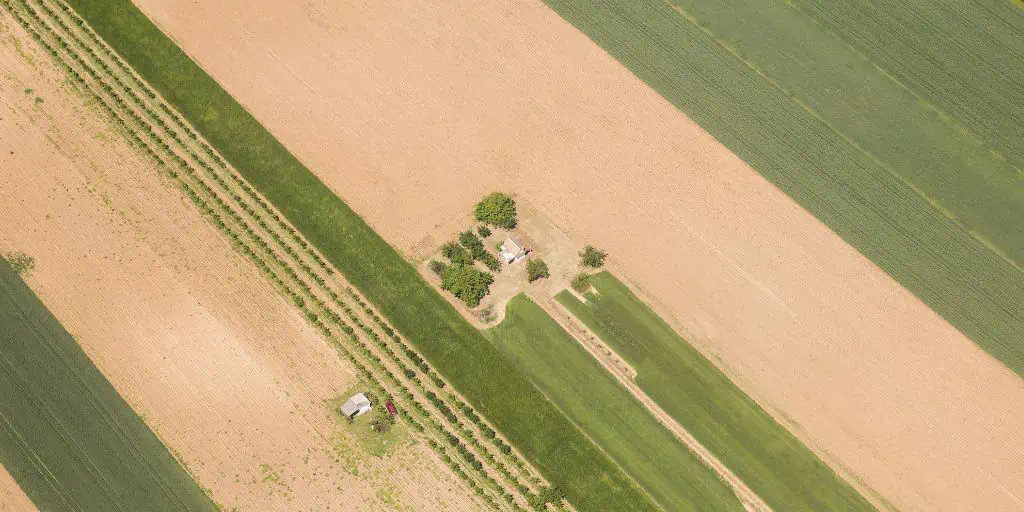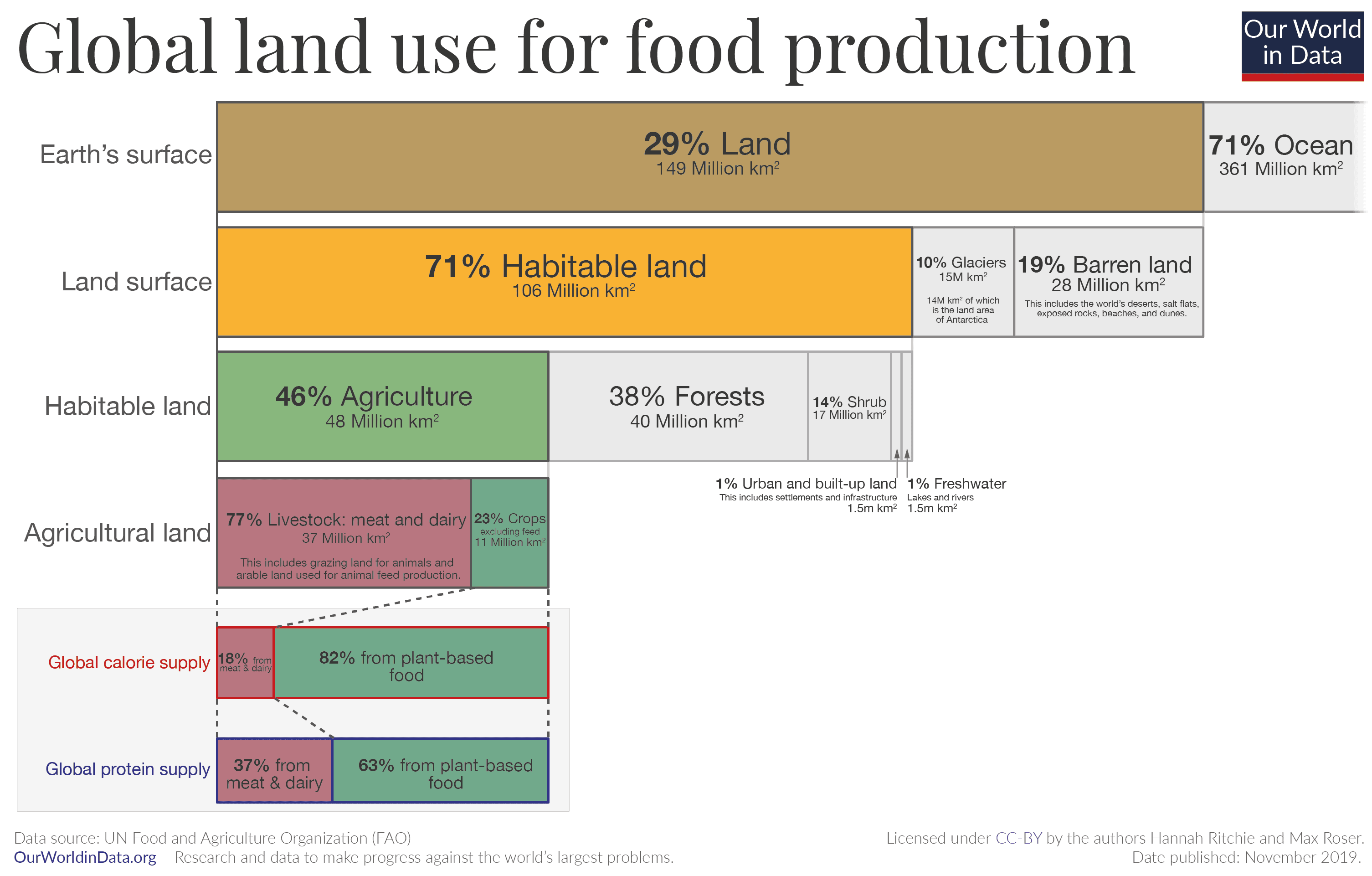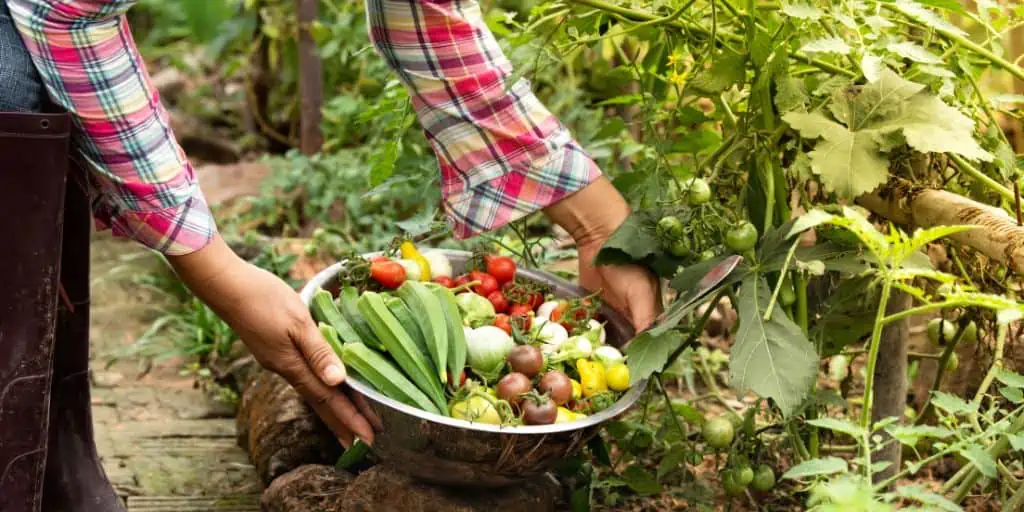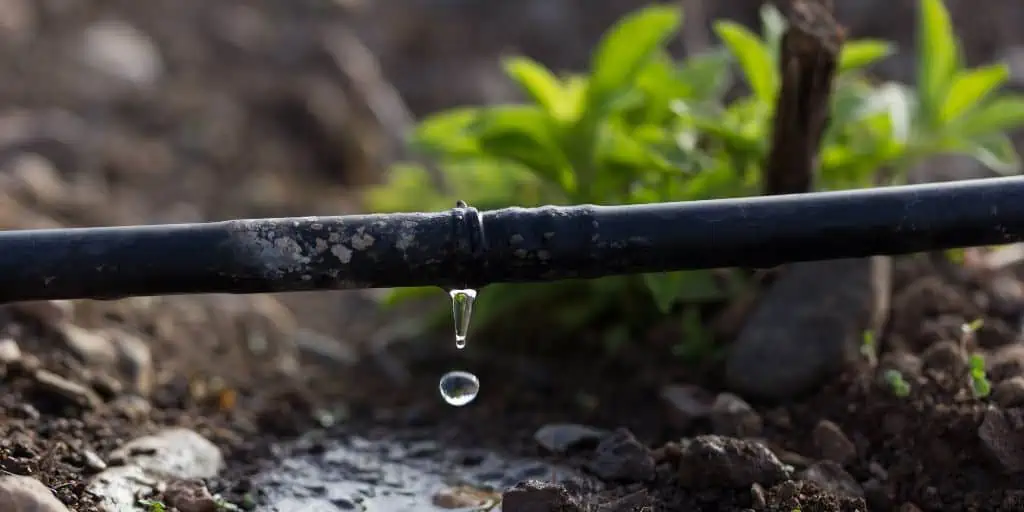What Is Arable Land?
Shortcuts
- Arable land refers to land suitable for growing crops, characterized by factors like fertile soil, adequate drainage, and appropriate climate.
- Just over 10% of Earth’s total land area is arable, making conserving and using it efficiently crucial for food production and sustainability.
- Arable land varies in productivity, from prime farmland with high productivity to marginal land with significant limitations for farming.
- Factors like urbanization, soil degradation, climate change, and competition for water resources pose challenges to maintaining arable land.
- Arable land is a valuable asset in the real estate and investment sectors.
Overview of Arable Land
Arable land refers to land that can be plowed and used to grow crops. It generally does not include heavily forested land, too rocky or stony, poorly drained, or prone to flooding.
The term “arable” comes from the Latin word arabilis, which means “suitable for plowing.”
Arable land possesses specific characteristics that make it suitable for agriculture. These include fertile soil, adequate drainage, appropriate climate conditions, access to water resources, and the absence of excessive slope or erosion[1]. The presence of these factors allows farmers to cultivate crops efficiently and sustainably.
Arable land makes up around 12%[2] of the total land area on Earth. This figure translates to about 1.5 billion hectares of land vital for food production[3], according to the United Nations Food and Agriculture Organization (FAO).
With rising human populations and increasing pressure on global food supplies, arable land remains a limited and precious natural resource. Understanding what types of land qualify as arable can help governments, farmers, and citizens make more strategic decisions about land use and food security.
How Arable Land Is Classified and Measured
Arable land is measured using various methods, including satellite imagery, soil surveys, and land use data. It is classified based on its suitability for agriculture, accounting for soil quality, drainage, slope, and climate conditions.
Several key factors determine whether land can successfully support crop production, including:
- Soil quality: Fertile soils high in nutrients are best. Ideal soils are loose, well-draining, and resilient enough for tilling[4]. Clay or rocky soils are challenging for growing crops.
- Topography: Flat or gently sloping land is easiest for farm equipment access and irrigation. Steeply sloped or uneven land poses risks like soil erosion.
- Climate: Warmth, rainfall levels, and frost-free seasons must support typical growing cycles. Too much or too little rain or extreme temperatures limit crop options. Land that receives 8 to 10 hours of direct sunlight is ideal[5].
- Drainage: Good drainage is essential to prevent waterlogging of soils. Soils must shed excess water while retaining enough for plant needs.
RELATED: Slope Savvy: Navigating the Ups and Downs of Hillside Construction
Those factors and humankind’s evolving agricultural methods define which lands worldwide are suitable to become arable and support cultivated agriculture. With proper soil management, farmers can utilize even marginally arable lands for crops over time.
Importance of Arable Land in Agriculture
Arable land plays a critical role in global agriculture and food production. It serves as the foundation for cultivating crops, providing the necessary resources for growing and harvesting food.
Here are some key reasons why arable land is essential:
Food Security
Arable land is vital for ensuring food security. It allows farmers to grow a variety of crops that provide a diverse and nutritious diet[6] for the population. Food availability would be severely limited without arable land, leading to food shortages and increased import dependence.
Economic Growth and Employment
The agricultural sector heavily relies on arable land for economic growth and employment. It provides opportunities for farmers, laborers, and related industries, contributing to rural development and overall economic stability. Arable land also supports the growth of agribusinesses, such as food processing and distribution, creating additional job opportunities.
However, agriculture’s contribution to gross domestic product (GDP) growth has recently declined for modern economies, as shown below:
Environmental Sustainability
Arable land management practices, such as crop rotation, soil conservation, and water management, contribute to environmental sustainability. Farmers can minimize soil erosion, reduce water usage, and preserve biodiversity by maintaining the health and fertility of arable land. Sustainable agricultural practices on arable land help mitigate the negative impacts of farming on the environment.
Climate Change Adaptation
Arable land can also play a role in climate change adaptation. Certain crops and farming techniques, such as agroforestry and conservation agriculture, can act as carbon sinks via carbon dioxide sequestration[7], reduce greenhouse gas emissions, and enhance the resilience of agricultural systems to climate variability.
How Arable Land Impacts Communities
A community’s access to arable land is foundational to its economic activity and quality of life. Other than its obvious roles in agriculture and food security, arable land also impacts the community in these aspects:
- Rural economy: Farming provides jobs and income streams. It also drives business activity for crop storage, transport, processing industries, and more.
- Land use planning: Governments should consider competing demands like urban sprawl versus maintaining farmland reserves and strategic food production capacity.
- Property values: Arable land tends to hold higher property values than land unsuitable for agriculture due to income generation potential.
- Heritage and culture: Farming shapes cultural identities[8], crafts, and traditional knowledge systems tied to harvesting local lands, flora, and fauna.
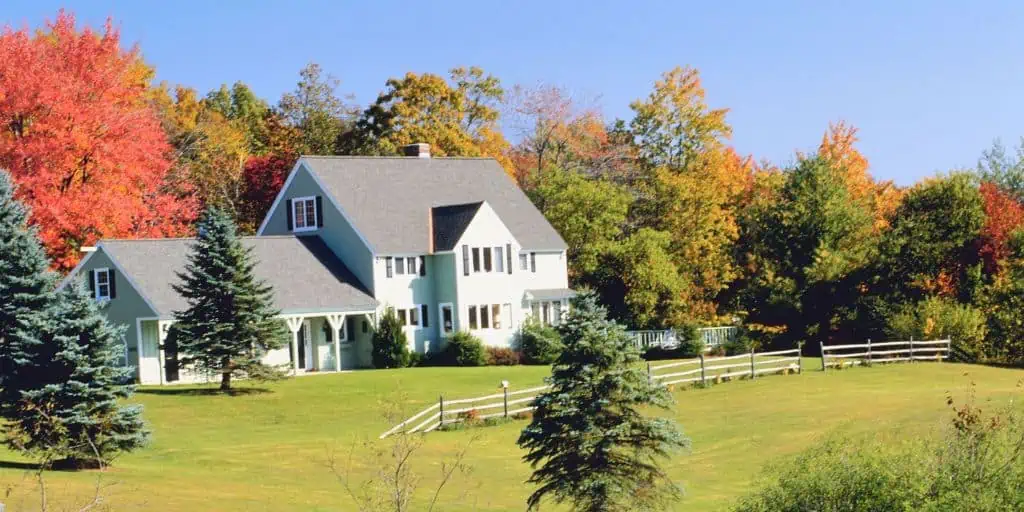
The American Farmhouse style is born from the farmhouse styles of the mid-1800s, with central chimneys, wraparound porches, and asymmetrical structuring with a characteristic gable at the front.
Arable Land as an Investment
The United States owns a significant amount of arable land, making it one of the world’s leading agricultural producers. Approximately 17% of the total land area in the United States[9] is classified as arable land suitable for agriculture.
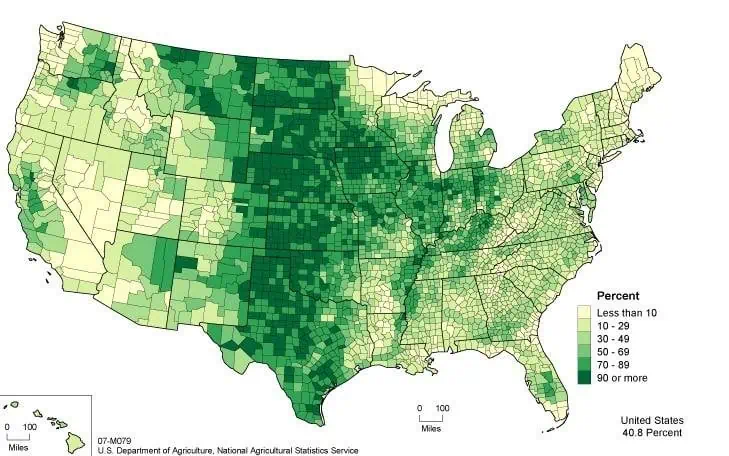
Farmlands in the United States
Because of this, many investors find agricultural land appealing. Here’s a closer look at the role of arable land in the context of real estate investing:
Real Estate
Arable land is a valuable asset in the real estate market, particularly in agricultural regions. Investors, farmers, and developers often acquire and trade arable land for various purposes. Agricultural land can be used for farming operations, ranching, timber production, or conservation.
The valuation of arable land can depend on various factors[10], including location and soil quality. Its proximity to markets contributes to higher values per acre as well as the availability of water for irrigation. Investors may also use comp data to arrive at a more accurate figure.
Finance and Investing
Arable land presents opportunities for finance and investing in the agricultural sector. Investors may purchase arable land as a long-term investment, capitalizing on its potential for appreciation and income generation through agricultural activities.
Additionally, various financial instruments, such as agricultural mortgages and land lease agreements, facilitate financing of arable land acquisitions and agricultural operations.
Farmland Investing
Farmland investing has gained popularity recently, attracting institutional investors and individuals seeking portfolio diversification and stable returns. Investment vehicles, such as real estate investment trusts (REITs) and farmland funds, allow investors to access the agricultural sector without directly owning and managing arable land. Farmland investing provides an opportunity to participate in arable land’s potential long-term value appreciation while benefiting from the steady income generated by farming operations.
Frequently Asked Questions: Arable Land
Is there less arable land now than in the past?
Yes, decreasing amounts of arable land represent a major sustainability concern. Estimates suggest around 12 million hectares of productive land are lost annually[11] due to soil degradation, climate change impacts, and land development for housing and infrastructure. Given the mounting pressure of global population growth, recapturing even marginally productive lands is essential.
Global arable land faces various threats, such as urbanization, soil degradation, climate change, and competition for water resources. These factors pose challenges to maintaining and expanding arable land for agricultural purposes.
What techniques help maximize yields on existing arable land?
Advanced practices like irrigation, fertilizers, mechanization, selective breeding, rotated crops, and integrated pest management maximize harvests.
Agroforestry also boosts soil fertility. It involves systematically planting trees or shrubs amidst crops, which provides benefits like nitrogen fixing, windbreaks, erosion control, and wildlife diversity. It can also help mitigate the worst effects of climate change on agricultural land[12].
Which countries have the most arable land?
The top five countries with the largest arable land areas (in descending order) are the United States, India, Russia, China, and Brazil[13].
Asia alone accounts for about 36% of global arable land, followed by Europe at around 20%[14].
However, arable land amounts per capita are also relevant—smaller nations may remain self-sufficient due to high per capita arable quantities[15]. The top five countries with the most arable land area per capita (in descending order) are:
- Kazakhstan (1.63 hectares of arable land per person)
- Australia (1.24 per person)
- Canada (1.04 per person)
- Argentina (0.88 per person)
- Russia (0.84 per person).
For comparison, the United States has 0.483 hectares of arable land per person.
Sources
- Anderson, S. (2023, January 17.) Cattle and Land Use: The Differences between Arable Land and Marginal Land and How Cattle Use Each. University of Califoria, Davis. Retrieved from https://clear.ucdavis.edu/explainers/cattle-and-land-use-differences-between-arable-land-and-marginal-land-and-how-cattle-use
- Arable land (hectares per person). (n.d.) The World Bank DataBank. Retrieved from https://databank.worldbank.org/metadataglossary/world-development-indicators/series/AG.LND.ARBL.HA.PC
- Folnović, T. (n.d.) Loss of Arable Land Threaten World Food Supplies. AgriVI. Retrieved from https://www.agrivi.com/blog/loss-of-arable-land-threaten-world-food-supplies/
- Stivers, L. (2023, January 24.) Introduction to Soils: Soil Quality. Pennsylvania State University Extension. Retrieved from https://extension.psu.edu/introduction-to-soils-soil-quality
- Office of Public Outreach and Communication. (2020, April 7.) Choosing the Right Location for Your Vegetable Garden. Rutgers, State University of New Jersey. Retrieved from https://sebsnjaesnews.rutgers.edu/2020/04/choosing-the-right-location-for-your-vegetable-garden/
- De Pee, S. (2013, March 6.) Food Security. Encyclopedia of Human Nutrition (Third Edition), pp. 353-360. Academic Press. ISBN 978-0123848857. Retrieved from https://doi.org/10.1016/B978-0-12-375083-9.00127-6
- Schahczenski, J. (2022, February.) Agriculture, Climate Disruption, and Carbon Sequestration. ATTRA – National Center for Appropriate Technology. Retrieved from https://attra.ncat.org/publication/agriculture-climate-disruption-and-carbon-sequestration/
- Agriculture & Subsistence in Cultural Landscapes. (n.d.) National Park Service. Retrieved from https://www.nps.gov/subjects/culturallandscapes/agriculture.htm
- United States – Arable Land (% Of Land Area). (n.d.) Trading Economics. Retrieved from https://tradingeconomics.com/united-states/arable-land-percent-of-land-area-wb-data.html
- How to Assess the Value of Farmland. (2023, September 28.) Farmer’s Business Network. Retrieved from https://www.fbn.com/community/blog/assess-farmland-value
- Every Year, 12 Million Hectares of Productive Land Lost, Secretary-General Tells Desertification Forum, Calls for Scaled-up Restoration Efforts, Smart Policies. (2019, July 27.) United Nations Press. Retrieved from https://press.un.org/en/2019/sgsm19680.doc.htm
- Bentrup, G., MacFarland, K. (n.d.) Agroforestry. USDA National Agroforestry Center, U.S. Forest Service. Retrieved from https://www.fs.usda.gov/ccrc/topics/agroforestry
- Arable Land by Country 2023. (n.d.) World Population Review. Retrieved from https://worldpopulationreview.com/country-rankings/arable-land-by-country
- Lyuri, D. (2008, August 6.) Agriculture. Encyclopedia of Ecology, pp. 76-84, ed. Sven Erik Jørgensen, Brian D. Fath. Academic Press. ISBN 978-0080454054. Retrieved from https://doi.org/10.1016/B978-008045405-4.00838-7
- Arable land (hectares per person). (2019, December 28.) Index Mundi. Retrieved from https://www.indexmundi.com/facts/indicators/AG.LND.ARBL.HA.PC

